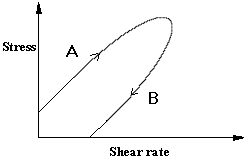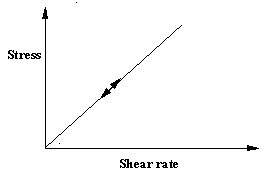
Flow Curve without Inertia Correction
When a stress is applied to a sample, the sample moves and continues to move while that stress is applied. If the stress is subsequently removed, the sample stops moving, but not instantaneously. It requires a finite time to respond to this change in stress. This lag time is due to inertial effects and its magnitude is entirely sample-dependent.
In flow experiments, the effect of inertia is more pronounced when using low-viscosity fluids. Inertial effects in flow experiments appear as apparent thixotropic loops when continuous UP and DOWN flow tests are carried out. Consider the graph shown below.

Flow Curve without Inertia Correction
This graph could be interpreted as a flow curve on a thixotropic sample, highlighted by the presence of the hysteresis loop. However, the fact that the UP curve (A) is parallel to the DOWN curve (B) and that the DOWN curve (B) has a shear rate at zero stress alerts us to the fact that this apparent thixotropy is actually an inertial artifact. The inertia correction available in the software eradicates such artifacts.
The same sample as above but measured with the inertia correction ON would yield the results shown below.

This now shows a Newtonian response, which is expected. This inertia correction only needs to be active when low-viscosity materials are being measured.